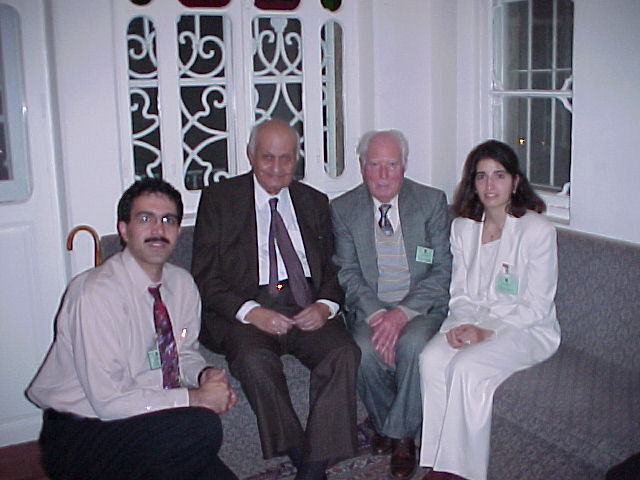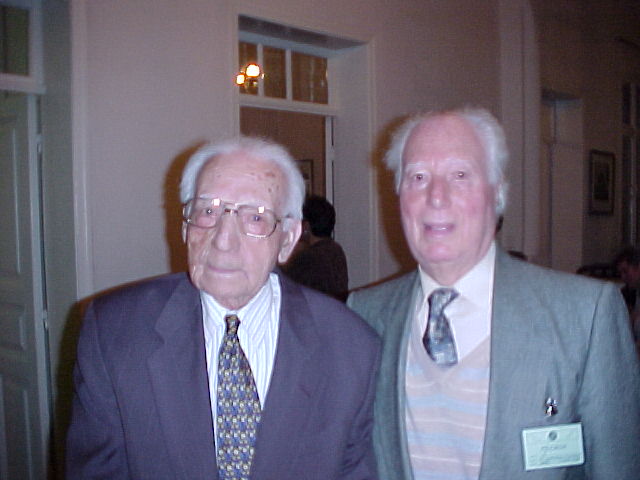
|
|
Abstract: Contemporary notes about a pilgrimage in 2000, with photographs of Dr. Varga and 'Ali Akbar Furutan. |
Next, I should acknowledge that I am aware that the Writings suggest that there is a difference between the emotions and what we might call spiritual. I do not profess to completely understand the word or the meaning of "spiritual." My personal experience confirms that the more we can get rid of the rational and emotional garbage in our heads, the more we can experience spiritual. I also can confirm that being in the Holy Land, specifically at our Shrines, has a major impact on our spirit. There is a reality there that is removed from our day-to-day lives in a strange and subtle way.
One of the Persian friends and I had several conversions about our approach to the different Shrines. She and I agreed that for the Bab and Abdu'l-Bahá, we had sort of a friendly conversation & relationship. They feel approachable and like we can "talk" with them about insignificant things. The Shrine of Bahá'u'lláh is too powerful for that, and she and I both felt a sort of reverent silence while there. There is a feeling that you are in the presence of the Central figures when you visit their Shrines. The Guardian said that the primary purpose of pilgrimage is to pray at the Shrines. I can only vaguely imagine what it must have been like for the early believers to visit the real people while they were alive on this earth. There are many anecdotes about how overwhelming the experience was, and how people became unable to speak, or involuntarily bowed down. I do understand that now because the same thing happens at their Shrines.
The general public visits the Shrines during certain times of the day. Pilgrims are welcome to visit then, too, but are warned that it is a very different experience. I never went while the public was there, although several times saw people trying to get to the Shrines when they were not open to the public but the gardens were. Literally bus loads of people visit Mt. Carmel and go to the Shrine of the Bab. I can only imagine people wandering around the Shrines and talking about trivial things and being a tourist in the Holy Places. I did not want to see it. The issue, though, is a matter of preparation and attitude. This must have also been true of the Central Figures in life. You either recognize them and it is very powerful, or they appear as ordinary people. Or as a prisoner in chains. Or some displaced Persian guy. It is a great gift and bounty to have gone there as a pilgrim and to have a good understanding of the history of our Faith.
Shrine of the Bab. This place you visit on your first day, a formal visit. We went in as a group and one person after a bit reads aloud the Tablet of Visitation. There are two side entrances into the Shrine, and I mostly used the one that I entered on this first visit. I went to this Shrine often. For my first two days in the Holy Land, I cried a lot on this Threshold. It was a cleansing sort of blubbering. I usually went in when I could be by myself and found myself overwhelmed with emotion. One thing that brought my tears was the image of Abdu'l-Bahá laying the remains of the Bab into the Sepulcher and then sobbing aloud. The other aspect was my own inadequacy and the feeling that I didn't deserve to be there. It is difficult to explain this without leaning too much on the Christian concepts of sin and forgiveness of sins, but that is sort of what came out. I felt that all my inadequacies were first experienced a-new and then forgiven. It was like being released of them. Washed of them! After about two days, I stopped crying and then appeared as reasonably composed as any other person. So although this part of my experience could be considered largely emotional, it strikes me as deeply spiritual in a way that I do not comprehend.
During one of the evening talks, the speaker mentioned that our teaching of the Faith is hampered by our inability to overlook our own inadequacies. We should not look at our own imperfections. They get in our way. "We seem to say to ourselves that if I were God, I would never forgive me. God has a sort of contract that if we offer our shortcomings, He will forgive them." (Cf. The Hidden Words.) "Bahá'u'lláh seems to like to take a fallen soul and bring them up as an example to other Bahá'ís." --Hooper Dunbar. Another speaker mentioned that the only experience that reproduces the pilgrimage in our hearts is when we are teaching the Faith.
The Shrine of Abdu'l-Bahá. This was like a rest period for me, a place to be peaceful for a moment. I found it very handy to have memorized a lot of Abdu'l-Bahá's words & prayers to recite in my head while I was there.
The Shrine of Bahá'u'lláh. I did not have the emotional component of the experience while here. Or at least not the sobbing aloud version. It is more of an empty-head feeling, in a positive sense, and a place of immense beauty and reverence. After entering the door, you walk into the portico, an area covered by glass with a garden in the middle. At one corner is the room with the Shrine itself, or the Threshold, and when with the whole group, we sort of take turns approaching this Threshold and then exiting. It is amazing that this process works so beautifully. No one sits there and says, "OK, your turn, next." But it works out that way. A whole book could be written about what component of our Writings creates this in us, makes us have the sense of when it is time to allow the next person access to a certain spot. In fact, the Shrines are silent except for the birds outside singing, occasional snuffling and throat clearing, movement of clothing sounds, and joints creaking.
I will forever remember a small orange tree in this area, under the portico, that had fruit on it. The sun came through and illuminated the oranges and was so beautiful. They glowed with a life that was ethereal, almost like the proverbial aura. Also in this garden was some kind of small fern-like plant that grew upwards onto a trellis and onto the lamps that were hanging from the ceiling, so that they formed an imperfect shape that was delicate and delightful. This as contrast to the perfectly manicured gardens on the exterior and in the other gardens. (Our gardens are becoming famous among the Israeli people and are very popular tourist destinations.) I love it that on the interior of the Shrine, well, in the portico, is this fern-thing growing rather haphazardly. Pilgrims do not enter over the Threshold of the Shrines. I suppose no one does except custodians. (Each holy place has a custodian; the term is more inclusive than just someone that cleans up.)
Sigh. I find that my diatribe here is deteriorating into just description. It is indeed difficult to convey the spiritual aspects of the pilgrimage. I am certain that it has a spiritual effect that is unlike anything I have ever known or imagined. Part of that effect is along the lines of "forgiveness of sins," so to speak. Another is about renewal. Another is about a sublime happiness that invades my being to the very core, and is as real and tangible as anything. Another is the physical beauty of the Shrines and holy places, and the wonder of Akka. Another is the rational-thought component, the new understanding of where the Central Figures lived and moved and breathed. The volume of consistent words that flowed from those Pens is proof enough of their Reality. I have a new understanding of the phenomena of Revelation, how knowledge flows from our Creator to the creatures, little ol' me.
 Dr. Varga [other figures not identified] |
 'Ali Akbar Furutan [other figures not identified] |
I suppose nothing really compares to the experience of meeting the Hands.
I asked... most sheepishly and embarrassed I was, too... Mr. Furutan why Shoghi Effendi did not have any children. He looked at me very carefully and intensely for a moment, then said,
"I was secretary of the NSA for 24 years and I know personally several people that went to the Guardian and said 'Beloved Guardian, I can't have children.' and the Guardian would pray for them and...." [Mr. Furutan lifted his hands in a gentle fashion and smiled sweetly] "They became fathers. Now I know that the Guardian was capable of doing for himself what he was able to do for others. This means that it was not wise for the him to have children."
So, my most burning question WAS answered while I was on pilgrimage. It wasn't the answer that I expected, but it satisfies me completely. I still can't beleive that I had the nerve to ask Mr. Furutan! What was I thinking! Gad! What a birdbrain.... I was drinking tea later, and recovering from my red face, when I told another pilgrim about this question. This other pilgrim said he had been at a conference when Ruhiyyih Khanum spoke, and somebody asked from the audience why they didn't have children, and she answered humorously, "I can assure you it was not for lack of trying!"
Shoghi Effendi, who died of Asiatic Flu on Nov 4, 1957 in London, married Mary Maxwell in 1937. She was surnamed 'Amatu'l-Baha Ruhiyyih Khanum, and passed away herself in 2000.
|
|